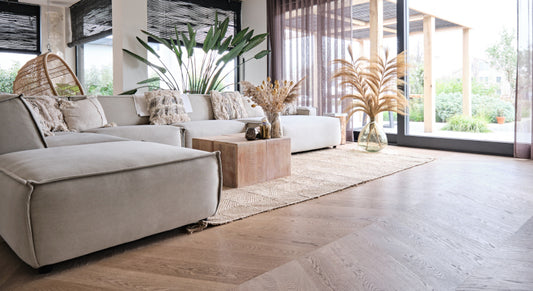PVC Vloeren, Nadelen Voor Gezondheid Van Baby's En Kinderen

Datum: 9 juni 2023
Leestijd: 6 minuten
Auteur: Uipkes Houten Vloeren
PVC (PolyVinylChloride) is a thermoplast (plastic) that can be harmful to the health of babies and children . Yet PVC is used in many products, including PVC floors.
Many people are not aware of the disadvantages of PVC floors and the possible harmful effects on health. In fact, PVC floors have become increasingly popular in recent years due to their affordability and wide choice of colors and prints.
Not a good development if you ask us.
Why Can PVC Floors Be Bad for Health?
The harmful substances that can be contained in PVC floors can be released over time. As a result, babies and children are exposed to the substances. That's quite shocking when you consider that babies and children:
- A lot of crawling on the floor and playing
- Have a higher breathing rate than adults
- Many people sit with their hands to their mouths
In addition, babies and children are extra sensitive to the possible consequences of exposure to harmful substances. This is because the organs and the immune system are still developing. Our advice is therefore not to install a PVC floor if babies and/or children live in the house.
High temperatures make the problem worse
Underfloor heating and sunlight can heat the PVC floor up to 50 degrees. This can ensure that harmful substances that may be in the PVC floor are released more quickly. In areas with a lot of sunlight and little ventilation, it is therefore important to ventilate well and use sun blinds and/or air conditioning, so that the so-called release of the substances is minimized. But then you are still faced with a dilemma in winter: • Are you going to turn on the underfloor heating , even though you know that this may release harmful substances? • Are you going to leave the underfloor heating off, making it uncomfortable in the house? Exactly Both aren't nice.
PVC Floors And Plasticizer
PVC floors owe their flexibility to plasticizers. Until 2020, phthalates were the most commonly used plasticizers. Due to health and environmental concerns, manufacturers have switched to other plasticizers. Examples of this are:
• DOTP (Dioctyl terephthalate)
• DINP (Diisononyl phthalate)
Safety of plasticizers in PVC Floors
The use of other plasticizers has led to improvements, but that does not mean that there are no longer any health risks:
DOTP (Dioctyl terephthalate): DOTP is considered a safer alternative to harmful plasticizers, but research into its health effects is still ongoing.
DINP (Diisononyl Phthalate): The European Chemicals Agency (ECHA) has concluded that current uses of DINP do not pose a risk to human health. However, the International Agency for Research on Cancer (IARC) has classified DINP as possibly carcinogenic to humans (Group 2B).
The above substances have the potential to be released from the PVC floor, resulting in exposure. If you ask us, alternative plasticizers are therefore not a solution.
PVC Floors And Sustainability
PVC floors can not only be harmful to your health, but also to the environment. PVC floors are 'oil based' instead of 'bio based'. The production of a PVC floor requires a lot of energy. In addition, production often takes place in producing countries that get their energy from coal-fired power plants.
In addition, the long transport causes unnecessary environmental pollution and PVC floors are not biodegradable, which means that toxic chemicals can be released into the environment if the floor is burned or ends up in landfills.
Regulations Lagging Behind
With the knowledge about the adverse effects of PVC floors, you would expect that stricter regulations have been drawn up to prevent damage to health and the environment.
However, no standard has yet been established in Europe regarding permitted emissions for PVC floors. The result is that cheap PVC floors without a quality mark are for sale that may contain harmful substances, while most consumers are unaware of this.
Why isn't anyone sounding the alarm?
That does happen, but so far with insufficient results. For example, the HCWH (Health Care Without Harm) Europe published the report The polyvinyl chloride debate: Why PVC remains a problematic material and Greenpeace released the report Hazardous Chemicals in PVC Flooring.
Hopefully more publications will follow to raise awareness of the disadvantages of PVC floors, so that people choose a different type of floor.
Conclusions
In summary, PVC floors offer the following disadvantages:
- PVC floors may contain substances that can be harmful to the health of babies, children and your own health.
- Even though alternative plasticizers have been used in PVC floors since 2020, there are still uncertainties about the safety of these plasticizers.
- Underfloor heating and sunlight can ensure that the harmful substances that can be contained in PVC floors are released more quickly.
- PVC floors can be harmful not only to your health, but also to the environment. This is because the entire life cycle (production, use and processing) is polluting.
In addition to the above list, there are even more disadvantages to PVC floor parts. For example, the limited lifespan and that damage to a PVC floor is difficult to repair. We go into this in more detail in the blog 'The disadvantages of PVC floors' .
All in all, our conclusion is: remove the PVC floor and have a different type of floor installed, such as a wooden floor .
Vragen? Kom langs voor advies!
Used sources
- • https://noharm-europe.org/documents/polyvinyl-chloride-debate-why-pvc-remains-problematic-material
- https://nl.wikipedia.org/wiki/Polyvinylchloride https://nl.wikipedia.org/wiki/Vinylchloride
- https://nl.wikipedia.org/wiki/Thermoplast https://strooming.nl/thuis/blog/binnenmilieu/pvc-vloeren-nadelen-gezondheid/
- https://www.epa.gov/indoor-air-quality-iaq/volatile-organic-compounds-impact-indoor-air-quality
- https://www.angi.com/articles/what-pvc-outgassing-my-plumbing.htm
- https://www.arboPortal.nl/onderwerpen/vluchtige-organische-stoffen
- https://www.greenpeace.to/publications/pvc_flooring.pdf
- https://ec.europa.eu/environment/pdf/waste/pvc/en.pdf
- https://www.europeanplasticisers.eu/
- https://www.sciencedirect.com/science/article/abs/pii/S0048969712008297
- https://echa.europa.eu/documents/10162/31b4067e-de40-4044-93e8-9c9ff1960715
- https://monographs.iarc.who.int/wp-content/uploads/2018/09/ClassificationsAlphaOrder.pdf https://pubmed.ncbi.nlm.nih.gov/15740755/
- https://pubmed.ncbi.nlm.nih.gov/10231983/
- https://pubmed.ncbi.nlm.nih.gov/30037974/
- https://www.anses.fr/en/content/labelling-building-and-decoration-products-respect-voc-emissions
Frequently Asked Questions
What are sustainable alternatives to PVC floors?
Floors made from renewable raw materials are sustainable alternatives to PVC floors. Examples are cork floors, bamboo floors and wooden floors. All these floors are made from natural raw materials instead of chemicals.
What is the advice of the HCWH regarding the use of PVC floors?
On page 29 of the reportThe polyvinyl chloride debate: Why PVC remains a problematic materialstates the following recommendation from the HCWH:
'Replacement of PVC in applications that pose a risk to human health through indoor exposure (such as floors and furniture) by 2030.' In our opinion, this says enough not to choose a PVC floor.
PVC is used in many products, does it make sense to choose a different floor?
Yes, the floor covers a large area of your home, which can increase the risk of damage to health. For that reason alone, it makes sense to choose a different type of floor.
Uipkes sells wooden floors, is cutting down forests sustainable?
Unfortunately, there are wooden floors for sale that are not durable. These floors often come from distant countries, such as China. The quality of these floors is a lot lower, which means that the lifespan of the floor is also shorter.
Uipkes wooden floors are made from European oak that comes from sustainably managed forests. In this way we limit the impact on nature and prevent unnecessary environmental pollution because the transport distances are limited.
Wooden floors are an expensive alternative to PVC floors, why should I choose that?
A wooden floor, if properly maintained, can last a lifetime. A PVC floor lasts approximately 10 years. In the long term, a wooden floor is actually cheaper than a PVC floor.
Stay up to date with news about floors and interior



